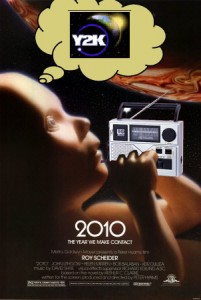As I said in my introduction to our subjective and opinionated review of radio in the 2000s, I still think it was darn near impossible to predict how the medium of radio would end up at the beginning of 2010. Sure, the seeds for satellite radio, HD radio, low-power FM, internet radio and MP3s were already planted by the turn of the century. But home broadband–nevermind wireless or mobile–was a relatively exclusive luxury. MP3 players were lucky to sport enough memory to hold about a hundred minutes of music and weren’t integrated into cell phones. Satellites for Sirius and XM were launched, and HD Radio was being experimented with, but no stations were on the air. Clear Channel was flying high for more than $90 a share.
Anyone taking a broad view of the radio industry in 2000 could certainly see a lot of balls being thrust up into to the air, but it would have taken a psychic to predict where they would land. Nevertheless, for all of the churn we can say very safely that audio-focused content is alive and well.
It’s become clear to me that we Radio Survivors do consider radio to be greater than just the traditional electromagnetic broadcast medium. While we included the RF-based college radio, pubic radio, LPFM, HD Radio and satellite radio in our review, we also touched upon internet radio, Pandora and digital downloads. I believe we are first and foremost fans of terrestrial broadcast radio, but that does not cause us to ignore or discount new audio media. Nor does it cause it us to claim that they are not, in essence, radio services.
The homogenization and delocalization of the broadcast dial caused listeners to seek alternative places to hear more interesting and diverse content. At the same time the popularity of MP3 players and Pandora shows that people were also looking for customization.
The thing I want to point out about all of these new options is that, truly, only one is wholly under the listener’s control: MP3s (or other digital music files). With all the other options, including Pandora, the listener still gives up some control over what comes next. With any service that has “radio” in its name, the programming is linear, and you generally don’t know what’s coming up. It doesn’t matter whether there’s a live DJ, a pre-programmed playlist or a library of tunes on random. You might choose an all-Springsteen or all-Mussorgsky station, but the actual song or piece is not under your control. With Pandora or Last.fm you choose an artist to set the tone and style, but all the subsequent plays are up to the algorithm.
What that says to me is that radio listeners–no matter the form of radio–are still looking for a curated experience. With music they may want more control over the genre, sub-genre, style, artist or time-period. With talk and information programming they want to choose the topic, host or political slant. But in both cases the listener wants somebody (or something) else to create the overall experience.
The fact that the major commercial radio companies so degraded this well-crafted experience helped drive away listeners to these other audio forms. Regardless, I believe there would have been erosion of commercial radio’s listenership triggered by these new ways of getting audio entertainment. It just might not have happened so fast and dramatically, and the big radio players might have been able to make the transition to online more smoothly.
As we look forward, the growing availability of wireless high-speed internet is going to make the medium itself less important than the programming that’s on it. I do think that each medium will continue to enjoy its own unique advantages. Whether it’s the low-tech ubiquity of analog broadcast, the nationwide coverage of satellite or the chaotic, but nearly infinite choices on the internet.
After content, the second most important factor will be how much hardware you have to buy. HD and satellite radio are already at a disadvantage because they require specialized equipment that (so far) doesn’t do much else. That makes it harder to compete with a mobile device that checks email and facebook, make phone calls, sends text messages AND receives thousands of online stations. If it were starting today, AM and FM radio would be at a severe disadvantage, too. But they enjoy a first-mover advantage, which means that receivers are so cheap and ubiquitous as to be nearly free.
I’m not sure there has to be any clear winners or losers here. I actually see the potential for coexistence amongst all these forms of radio. Whether or not that can or will happen is up to the companies, consortia and oligopolies who are mostly in control of the commercial, HD and satellite radio.
It should be an interesting listen.
In case you missed them, here’s a rundown of our 14 most important radio trends in the last decade. They’re in no particular order.
- #1: The birth and troubled childhood of satellite radio
- #2: The growth of Internet radio
- #3: I-tunes lures listeners away from terrestrial radio
- #4: Podcasting
- #5: The Age of Pandora
- #6: HD Radio launches, but who listens?
- #7: Internet Radio’s Day of Silence
- #8: The Great Fairness Doctrine Panic
- #9: The FCC authorizes Low Power FM
- #10: Clear Channel goes private equity
- #11: Cash strapped schools turn their backs on college radio
- #12: National Public Radio keeps growing
- #13: College radio tightens its playlist
- #14: Pacifica radio democratizes itself



